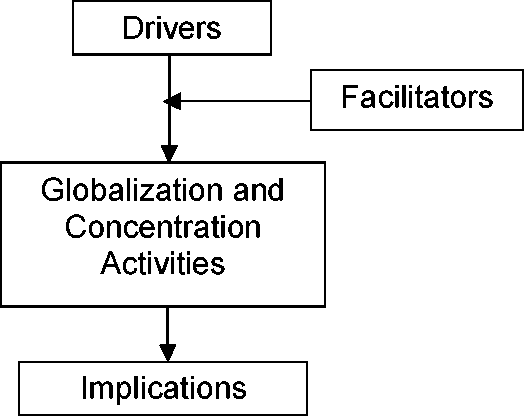Current Agriculture, Food & Resource Issues
D. Sparling and E. van Duren

Figure 1 A framework for analyzing globalization and concentration
control these global supply chains. Customer expectations for new products and more
variety encourage managers to seek new product and market opportunities outside the
organization, frequently through acquisition. In some industries, such as the red meat
industry, shrinking consumer consumption has contributed to increased concentration as
managers seek growth through acquisition (MacDonald et al., 2000).
In their attempts to reduce costs through streamlined supply chains and larger volume
purchases, organizations are reducing their supplier bases and working more closely with
those remaining. A prime example is Kmart’s decision in early 2001 to sole-source the
$3.7 billion in grocery purchases for its Big Kmart and Super K stores on the East Coast
(Howell, 2001). As company size increases through merger and acquisition (M&A)
activity, there are incentives for suppliers to the growing companies to grow as well.
When organizations become more global, there are advantages for global suppliers who
can serve the needs of these organizations in multiple markets for multiple products. The
supplying companies that survive and prosper will be those that develop the capabilities to
meet the needs of global customers.
In mature markets that are becoming saturated, concentration frequently increases as
firms seek growth through M&As. Many firms are forced to seek expansion alternatives
in foreign markets. This has been a major factor in the expansion of EU retailers into other
markets. For example, Royal Ahold now derives more than 70 percent of its revenue from
foreign sales (Tittleson, 2000).
32
More intriguing information
1. ROBUST CLASSIFICATION WITH CONTEXT-SENSITIVE FEATURES2. Firm Closure, Financial Losses and the Consequences for an Entrepreneurial Restart
3. THE ANDEAN PRICE BAND SYSTEM: EFFECTS ON PRICES, PROTECTION AND PRODUCER WELFARE
4. The name is absent
5. The constitution and evolution of the stars
6. Monetary Discretion, Pricing Complementarity and Dynamic Multiple Equilibria
7. Smith and Rawls Share a Room
8. Constructing the Phylomemetic Tree Case of Study: Indonesian Tradition-Inspired Buildings
9. Micro-strategies of Contextualization Cross-national Transfer of Socially Responsible Investment
10. A Note on Productivity Change in European Co-operative Banks: The Luenberger Indicator Approach